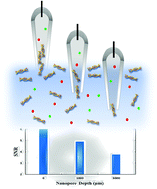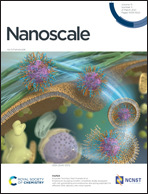Measuring trapped DNA at the liquid-air interface for enhanced single molecule sensing†
Abstract
Nanopore sensing is a promising tool with widespread application in single-molecule detection. Borosilicate glass nanopores are a viable alternative to other solid-state nanopores due to low noise and cost-efficient fabrication. For dielectric materials, including borosilicate glass, the capacitive noise is one of the major contributors to noise, which depends on the wall thickness and the surface area submerged in an ionic solution. Here, we investigated the root mean square (IRMS) noise and ionic conductance for borosilicate nanopores in different depths (i.e., tip submersion depth) ranging from the solution surface (assumed to be zero) to 5000 μm. Our findings demonstrate a decrease in IRMS noise as the pipette moves toward the surface. We further demonstrate that borosilicate nanopores can detect single lambda DNA (λ-DNA) molecules with a high signal-to noise ratio close to the liquid-air interface. Specifically, our results indicate a higher signal to noise ratio as the submersion depth is reduced owing to the reduced surface area and thus capacitive noise. Further, our experimental results show higher DNA capture frequency at the air–water interface due to a combined effect of evaporation and an evaporation-induced thermal gradient at the surface. Therefore, our findings demonstrate that borosilicate glass nanopores are suitable for studying interfacial concentration gradients of molecules, specifically DNA, with a higher signal to noise.



 Please wait while we load your content...
Please wait while we load your content...